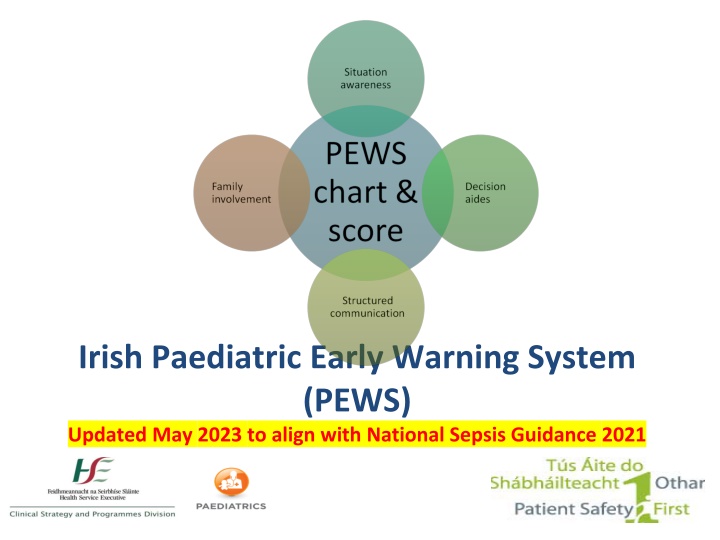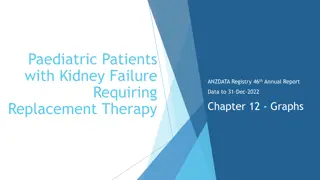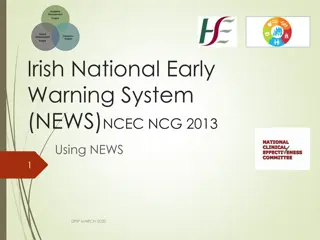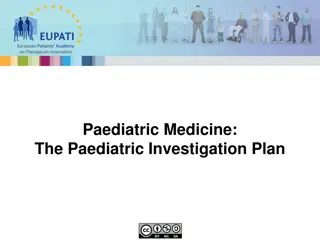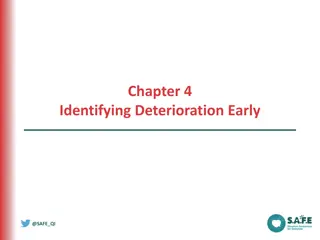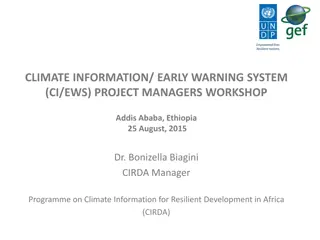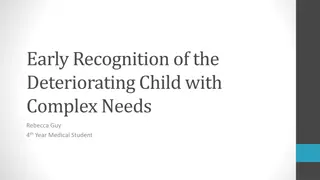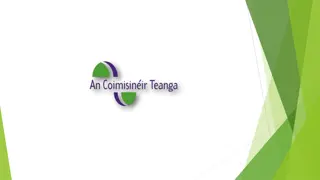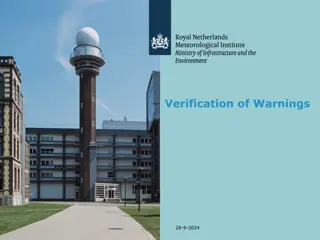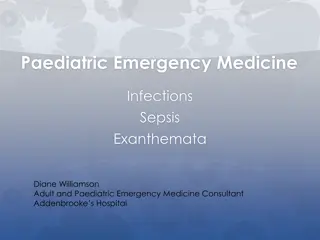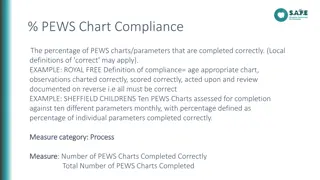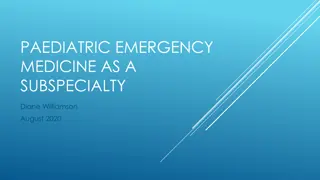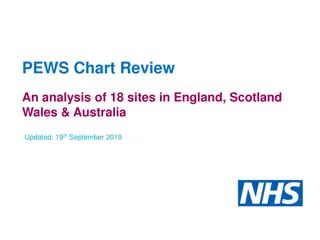Enhancing Pediatric Care with the Irish Paediatric Early Warning System (PEWS)
The Irish Paediatric Early Warning System (PEWS) has been updated to align with National Sepsis Guidance in May 2023. It aims to assist in recognizing and responding to deterioration in pediatric patients, emphasizing the importance of clinical judgment and individualized assessment. PEWS does not replace emergency response but serves as a valuable tool in clinical practice, enhancing team communication and decision-making. The DCU Systematic Review highlights positive trends in improving clinical outcomes. Learning outcomes include discussing PEWS utilization, documentation, and effective chart demonstration.
Download Presentation

Please find below an Image/Link to download the presentation.
The content on the website is provided AS IS for your information and personal use only. It may not be sold, licensed, or shared on other websites without obtaining consent from the author.If you encounter any issues during the download, it is possible that the publisher has removed the file from their server.
You are allowed to download the files provided on this website for personal or commercial use, subject to the condition that they are used lawfully. All files are the property of their respective owners.
The content on the website is provided AS IS for your information and personal use only. It may not be sold, licensed, or shared on other websites without obtaining consent from the author.
E N D
Presentation Transcript
Irish Paediatric Early Warning System (PEWS) Updated May 2023 to align with National Sepsis Guidance 2021
Learning Outcomes By the end of the session, you will be able to: Discuss the importance of clinical judgement and individualised assessment Discuss the use of PEWS in clinical practice Identify PEWS documentation Demonstrate effective use of PEWS charts Discuss the appropriate use of variance within PEWS
Aim of PEWS Assist recognition and response to deterioration Paediatric observation charts PEWS score
DCU Systematic Review Systematic review of 11 clinical guidelines & 70 research articles Grey literature review & interviews Review of detection & response systems, implementation & economic impact
DCU Systematic Review positive directional trends in improving clinical based outcomes there is no consensus and limited evidence about which PEW system is most useful or optimal for paediatric contexts
PEWS is... Team work & Communication Decision aides PEWS chart & score Situation Awareness/ Clinical Judgement Family Involvement
PEWS is not PEWS does not replace: Emergency response Clinical concern
Start date Variance 6 Core parameters Decision aides Additional parameters Total score
Aid to audit & handover Respiratory assessment tool
Triggers Core parameters Score 1 Nurse or family concerns 0,1, 2 Respiratory Rate 0,1,2,3 3 Respiratory Effort 0,1,2,3 4 Oxygen therapy (L+ pressure) 0,1,2 + 0,1 5 Heart Rate 0,1,2,3 6 AVPU 0,1,3 Additional parameters Score 7 SpO2 Capillary refill time (central) 0,1,2,3 8 0,1 9 Blood Pressure (systolic) 0,1,2,3 10 Skin colour No score 11 Temperature No score
Using the PEWS chart First time Addressograph x3 Year Start date Planned frequency of observations
Using the PEWS chart Every time Date, time of observations Nurse initials and NMBI PIN As required Frequency of observations Event Record
Concern (clinical) What is concern? How should it be assessed? Dot if present, score 1 Blank if not present, score 0 1
Airway + Breathing Respiratory Rate - RR Respiratory Effort RE Oxygen Therapy O2T (mode, O2, pressures) Oxygen saturations SpO2
Circulation Heart Rate HR Central Capillary Refill Time CRT Systolic Blood Pressure BP Skin Colour (no score) Mean BP = x x x
Disability AVPU 0 0
Exposure Temperature (no score) Urine output (no score)
Recording the Observations Example column: draw the dot, join the line Baseline + trending essential in recognition Individual parameter score total PEWS score Consider Reassess within
Additional Information DNAR Blood/blood product transfusion
Escalation PEWS does not replace an emergency call Minimum Observations Score Minimum Alert Minimum Response Any trigger should prompt increase in observation frequency as clinically appropriate 1 4 hourly Nurse in charge 2 2-4 hourly 3* 4-5 1 hourly Nurse in charge review Nurse in charge + 1st Doctor on call 30 minutes Urgent medical review Nurse in charge + 1st Doctor on call + Senior Dr. + Consultant 6 Urgent SENIOR medical review Continuous URGENT PEWS CALL 7 Immediate local response team *Pink score in any parameter merits review PEWS does not replace clinical concern
Urgent PEWS Call Response pathway to PEWS Score 7
Communication Identify You Recipient of information Patient Situation The situation is Concerns, observations, PEWS score etc. Background The background is (age, reason for admission, relevant medical/surgical history, relevant current treatment/interventions) Assessment My assessment is Give relevant ABCDE assessment information What do you think the problem is? Recommendation My recommendation is What do you need them to do? Recipient should provide any necessary clinical instruction.
Documentation Management plans following review: Impression Plan for intervention Plan for observations Plan for review Calling criteria
Variance Clinical judgement essential 3 levels Special situations Parameter amendments (chronic conditions) Medical escalation suspension (acute illness)
Special Situations Special situations Transient, simple cause for PEW increase Nurse-led decision not to escalate Must be documented Must have reassessment within a short timeframe
Special Situations Example Felix, age 6, admission post-tonsillectomy Observations 30mins following return to ward: o Felix crying that he is in pain o RR 34, HR 140, systolic BP 99 Drug chart indicates paracetamol may be given Total PEWS Score? Reasonable action?
Amended Parameters Senior medical decision Pre-existing conditions Not for acute presentation Amended range scores 0 Outliers trigger pink 3
Amended parameter example Doctor Signature/Print name/MCRN New Acceptable Range Next medical Review Date/Time Clinical Parameters for Chronic Conditions Amendment Parameter 12.04.16 O2 saturations 75-90% 1/52 Dr ### Doctor Signature/Print name/MCRN Dr #### New Acceptable Range Next medical Review Date/Time Clinical Parameters for Chronic Conditions Amendment Parameter 30.05.16 Systolic BP 135-140 3/7
Medical Escalation Agreement Conditional Senior medical decision Scoring due to current presentation/illness Wording: escalation not required if , no escalation provided ... state specific parameter ranges Score appropriately continue trending and monitor for changes Suspension of medical escalation only Caution in: cardiac conditions, newly admitted, newly discharged from PICU/ICU, on-call, non- respiratory parameters
Medical Escalation Agreement Medical Escalation Agreement Doctor Signature/Print name/MCRN Next Medical Review Date / Time Suspension Conditions Imp: acute asthma new admission Escalation not required provided: RR 25-45 RE Moderate (wheeze, I/C recession) SpO2 94% Alert for change in condition Imp: acute asthma responding No escalation required at PEWS 3 RR 15-35 RE Mild No oxygen requirement SpO2 98% Start date: 22/8 Start time: 03.30 Escalation not required at PEWS 5 provided: at PEWS 5- -6 6 2 hrs (05.30) or sooner if any concerns Dr ### End date: 22/8 End time: 05.30 Alert for change in condition Start date: 22/8 Start time: 05.45 8 hours (14.45) or sooner if any concerns No escalation required at PEWS 3- -4 if: 4 if: Dr ### End date: 22/8 End time: 14.45
PEWS single 3 or 4 Urgent medical review Escalate concern as appropriate PEWS Score 7 = Urgent PEWS pathway
Chart Completion scenario 1 10 week old, poor feeding RR 50 RE normal No supplemental oxygen HR170 Mottled skin Eye opening to mother s voice, flat Temp 39.5 C What is the score so far? What needs to be done now?.............. Slide 1 of 2
Chart Completion scenario 1 10 week old, poor feeding Additional information: SpO2 93% Central CRT 3 seconds BP 71/58 Slide 2 of 2
Chart Completion scenario 2 8 year old with asthma RR 55 RE moderate Receiving O2 therapy of 2L/min (nasally) SpO2 96% HR 145 AVPU - agitated and uncooperative Escalation agreement in place 3 hours ago, valid 1 more hour: RR 25-40, RE mod, SpO2 >95
Chart Completion scenario 3 13 year old with asthma RR 35 RE mild wheeze + recession no supplemental oxygen SpO2 98% HR 118 AVPU
PEWS care bundle Team work & Communication Decision aides PEWS observation chart & score Situation Awareness Family Involvement
PEWS Training Tips - Who are you training? - Create schedule - Venue/ environment - AV requirements - Pre-course organisation
